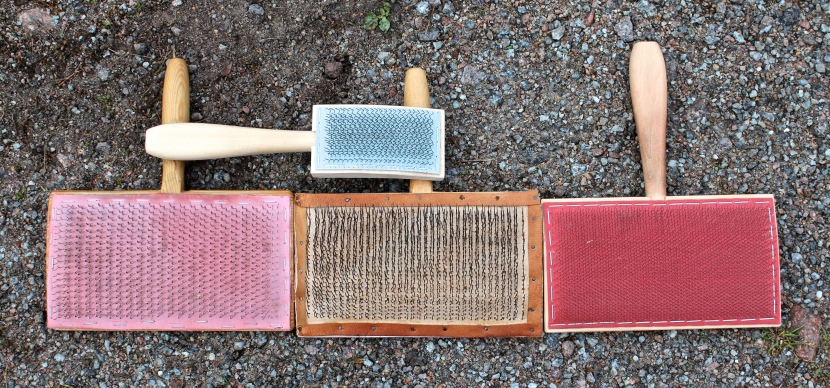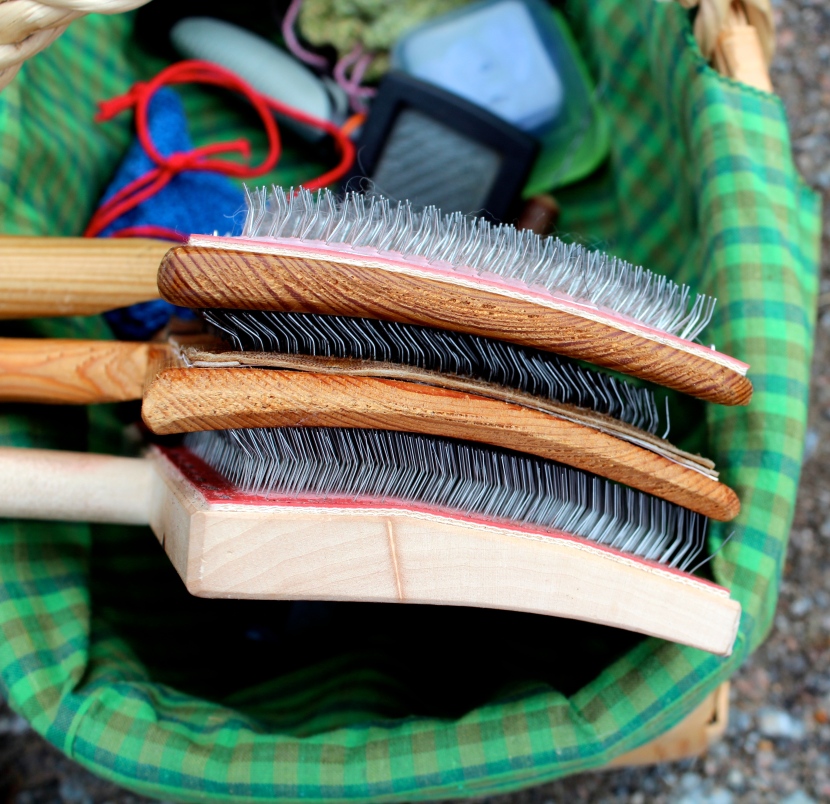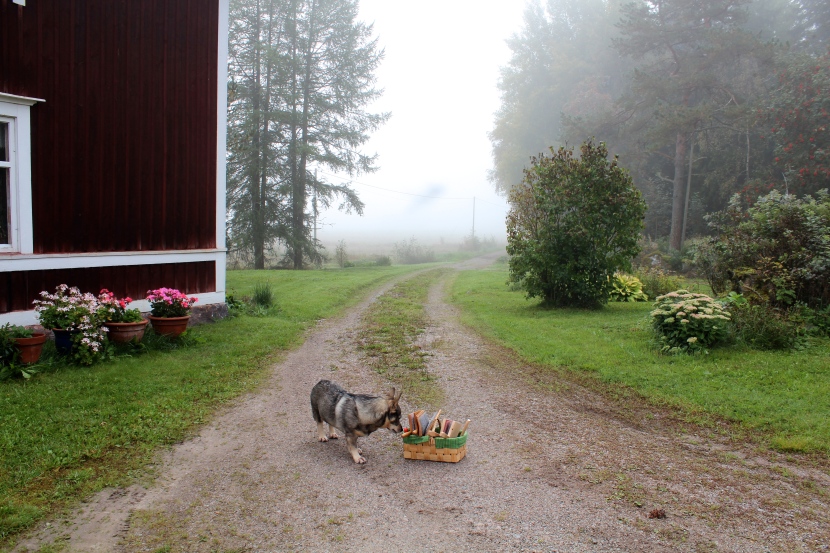Hand carders
At last! I took new photos this morning. Here they are. This is the treasure I found at the medieval event last Saturday:
New, unused carders from one of the renown card makers in Kokkola, Indola. The Kokkola area was known for high class carders from the end of the 19th century until the last one gave up and stopped making them in the 1980s. This is handcraft from beginning to end. The tines are mounted a pair at a time on leather. I had a pair that was very similar, worn out many years ago. Since then I’ve been looking for a pair of used Finnish carders, but didn’t find any I wanted to buy. There are second hand carders for sale every now and then, but they are often in very bad condition.
As you can see these also are a bit rusty. The old carders weren’t stainless like today, so no sprinkling of water on these carders is allowed. The very small rusty parts in my new carders will be kept rust free by using the carders, and adding a bit of oil to a few staples of wool every now and then and using it to clean and oil the carders. Or, by not scouring away all the lanolin from the wool. I’m one of those who doesn’t want to work with dirty wool. I scour almost all wool.
You can also see that these carders are not a matching pair. That doesn’t worry me, as I don’t switch hands when I card. I use the heavier card as my upper carder as it sits well in my hand. The card cloths are the same size.
Below three of my hand carders, and my flick carder. To the left are my old carders with a new cloth from Hedgehog Equipment. It’s plastic, so it has to be attached to the carder in a different way than leather cloth: by gluing it close to the wood. The fine cloth carder to the right is from Louet, also with the cloth glued. The Indola carder in the middle has a TPI (tines per inch) in between these two, and the tines are mounted on leather. The flick carder has strong, unbending tines.
Below: See how different the tines are in the three carders! On top the coarsest from Hedgehog, then Indola, and Louet fine. Notice that the leather isn’t glued to the wood. Instead the leather is glued to a sturdy piece of paper, and nailed onto the wood only around the edges as the leather must have space to move, otherwise it’ll crack. Also look at the wood grains: the two Finnish carders wood is turned in another way than the Dutch. I don’t know why that is, maybe it has something to do with the two different kinds of wood and the way the cloth is attached. My old carders naturally had leather cloth also, so the glue next to the wood is a new thing for them. Now this is NOT the way you store your carders, I only placed them like this so you could compare the tines. You store them belly to belly in order to protect the tines.
Here are all of my hand carders. The bench carders also have leather cloth, and they were made somewhere in Finland, maybe even at Indola. I got them as a wedding present, and my husband got a miniature plane so he could make a proper bench, but he was in a hurry and didn’t use it… I attach the mounted carder to the bench with clamps when in use.
Now why all these carders? For different kinds of fibers, obviously.
Louet fine: for very fine fibers like cotton, Merino, silk.
The coarse Hedgehog: for coarse, long wool and double coated wools like Åland, Värmland, and for opening other wools before carding on one of the other two.
The bench carders: for opening large amounts of fibers of all kinds. I sometimes use them for opening dog hair that is difficult to card and can be spun from a cloud.
Indola: for Finnsheep, Swedish Finewool, and other short, fine to medium wools. Indola’s carders are not a result of random card making. They are perfect for the wool they were made for, i.e. Finn. I can’t explain why the flexible leather, the sharply bent tines and the amount of tines per inch, is so perfect for these wools. But it is. I felt sheer, simple joy when I tested them at the booth in Kokkola and had the great pleasure of pairing two carders that seemed to be the best for my way of carding.
The label “Kardmuseum” indeed says “carder museum”. I still have to find out what that means. But obviously the equipment and also some of the raw material from Indolas kardfabrik is still stored somewhere in Kokkola. It was a cottage industry amongst other similar that sold carders all over Finland, and also exported carders to Russia around 1900. Before WWII Indola made some 50 000 pairs of carder yearly. Leather was another big business in the area, and that is one of the explanations why carders where made in several cottage industries there. For good carders you need good leather of the right kind: plant tanned sheep skin.
My little helper:






Wow..you’ve inspired me with your use of hand carders. I have a pair but tend to go to my drum carder first. I know I need to work on technique, but what I use my hand carders I tend to look like I got in a fight with a cat..I must not be very coordinated!
Oh dear 🙂 Watch a couple of videos on Youtube? You’re not supposed to give yourself a massage with the carders 😉
Fabulous. I was anxiously awaiting What it was you were so Anxiously awaiting! What a treat and a treasure you found. This is wonderful. I have pair from ? they are quite old but very useful, love them for Corriedale and I have cotton cards that I never use 🙂
I mostly wash in the lock, flick card and spin from the lock. Stuck in my ways 🙂
Congratulations!
Thank you 🙂
I have an old pair of cotton cards from Leicester, Massachusetts, but I never looked at them that closely! After reading this, I gave them another look, and they have the leather strip nailed on around the edges too. I would probably never have noticed that or known its significance, so thank you. It was also interesting to read about the different types of cards!
You have a treasure, then 🙂
That’s one good thing about living in an area where people are not into textiles so much – I can pick up some great things because no one else is collecting them! 🙂